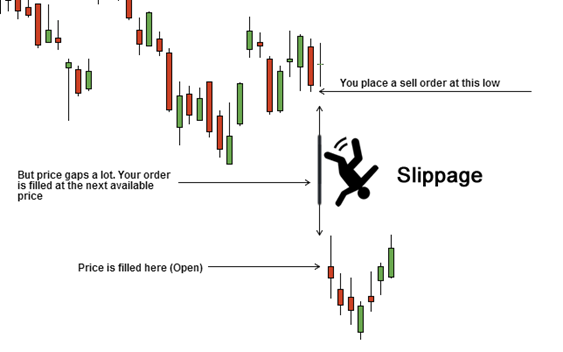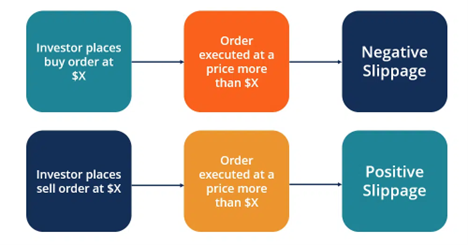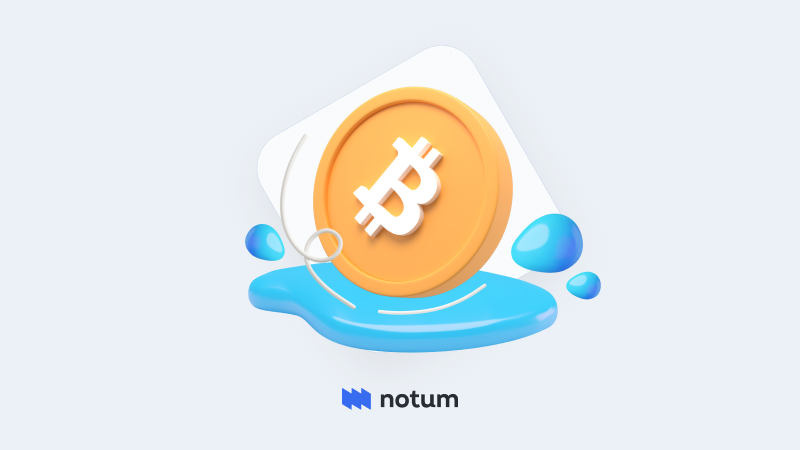Intro
In the crypto market, known for its volatility, multiple events can affect the price of a particular asset. Crypto slippage is a phenomenon where the expected price of crypto changes before the trade, which can be both good and bad for traders. But why exactly does the price slippage happen? Undoubtedly, understanding slippage and how to mitigate it is crucial to becoming a more informed and successful trader. In this article from Notum, we will pay attention to price slippage, explain how it works, and point out its main types. Furthermore, we will explore various strategies and techniques that can help traders and investors minimize the impact of slippage, ultimately enhancing their ability to navigate the markets with greater precision and profitability.
What Is Slippage?
Crypto slippage is basically the difference between the expected price of a digital asset at the time a trade is initiated and the actual executed price when the trade is completed. This deviation can result in a more favorable execution price, but it often works against traders, leading to higher prices. Slippage is primarily caused by the lack of liquidity in certain digital assets, coupled with the speed at which crypto prices can change. It can be particularly visible during times of high market volatility or when trading relatively illiquid tokens.
Slippage can have a significant impact on the profitability of crypto traders. It can lead to unexpected losses when buying assets at higher prices or selling them at lower prices than expected. That's why now there are multiple ways and strategies for traders to minimize crypto slippage.
Additionally, traders may choose to avoid trading during highly volatile periods, select more liquid assets, or use trading platforms and tools that offer advanced order types to help reduce the effects of slippage.

Source: Chaindebrief
How Does Crypto Slippage Work?
Crypto slippage occurs when there is a disparity between the expected price of a digital asset and the actual price at which a trade is executed. This can lead to both favorable and unfavorable outcomes for traders and investors. Slippage typically happens due to two primary reasons: market volatility and liquidity constraints. Cryptocurrency markets are known for their price fluctuations, where digital assets can experience rapid price changes within seconds.
When a trader places an order at a specific price, there is no guarantee that the market will meet that exact price when the order is executed. The difference between the intended price and the execution price is the slippage. This can result in traders buying assets at higher prices than they anticipated or selling them at lower prices than they intended.
Liquidity, or the ease with which an asset can be bought or sold without affecting its price, also plays an important role in crypto slippage. Less liquid assets more likely lead to slippage because there may not be enough buy or sell orders in the order book to fill a large trade at the desired price.
As a result, the market price may need to move to attract more buyers or sellers, causing the trade to be executed at a different price. Additionally, selecting assets with higher liquidity and trading during less volatile market conditions can help reduce the impact of slippage. Some advanced trading platforms offer features that can minimize slippage, such as stop-limit orders and post-only orders.
Types of Slippage
Crypto slippage mostly exists in 2 forms: positive and negative slippage:
- Positive slippage occurs when a trade is executed at a more favorable price than the one initially intended. This can result in better entry or exit prices, ultimately leading to increased profits for the trader. Positive slippage is typically seen as a beneficial outcome and is often associated with situations where market conditions are rapidly changing, but the executed price moves in the trader's favor. For example, if a trader places a market order to buy crypto at $50, but due to a sudden price drop, the order is executed at $48, and the trader experiences positive slippage.
- Negative slippage happens when a trade is executed at a less favorable price than what the trader intended. This leads to potential losses or reduced profits. Negative slippage is more common during periods of high market volatility and low liquidity. Suppose a trader issues a limit order to sell crypto at $100, but due to a sudden price change, the order is executed at $95. In this case, the trader experiences negative slippage as they had to sell at a lower price than they initially desired.

Source: CFI
What Causes Slippage in Crypto?
Slippage in crypto trading can be attributed to several key factors, each of which contributes to the expected and actual execution prices of a trade:
- Market Volatility. Cryptocurrency markets are highly volatile, with prices subject to rapid and unpredictable fluctuations. When traders place orders, the market conditions can change before the order is executed. This volatility can lead to slippage as the executed price may differ from the price at the time the order was placed.
- Liquidity Constraints. Less liquid assets, especially those with lower trading volumes, are more susceptible to slippage. When there are not enough buy or sell orders in the order book to match a large trade, the market price may need to adjust to attract more buyers or sellers, which can also result in slippage.
- Market Orders. These orders are executed at the prevailing market price when the order reaches the exchange. As market orders prioritize execution speed over price, they are more likely to experience slippage, especially during times of high volatility or low liquidity.
- Order Size. The size of the order can also affect slippage. Larger orders may need to be broken into smaller parts to reduce the impact on the market. When placing a large order, executing it all at once can lead to significant slippage, as the market may not have sufficient liquidity to handle such a trade without price adjustments.
- Exchange Delay. The time it takes for an order to reach the exchange and get processed can also lead to slippage. In fast-moving markets, even a slight delay in order execution can result in significant price change.
- News and Events. Major events, regulatory announcements, or market-moving news can cause sudden price changes in the crypto market. If such events occur while an order is in progress, it can result in slippage as the market quickly reacts to the news.
Slippage Tolerance: What Is It?
Slippage tolerance is the maximum deviation from the expected or specified price that a trader or investor is willing to accept when executing a crypto trade. It is a parameter set by the trader to manage the potential impact of price slippage on their trades. In volatile crypto markets, prices can change rapidly between the time an order is placed and when it is executed, leading to slippage.
This risk management tool helps traders strike a balance between achieving a more precise entry or exit point and the risk of their trades not being executed as expected. It allows traders to set their preferences based on market conditions and their allowable risk. By using slippage tolerance, traders can better control the potential impact of unexpected price variations on their trading strategies.
For example, if a trader wants to buy a specific crypto at $100 and sets a slippage tolerance of 2%, it means they are willing to accept an execution price of up to $102 ($100 + 2% slippage). If the market price at this time falls within this range, the trade is executed as desired. However, if the price exceeds the specified slippage tolerance, the trade may be partially filled at the allowable price, fully executed at the market price, or canceled, depending on the trader and the platform's capabilities.

Source: Medium
How Can You Minimize Slippage?
Minimizing crypto slippage is important for traders and investors to optimize their trading outcomes. The main strategies and techniques to help reduce the impact of slippage are:
- Set Slippage Tolerance. Many trading platforms allow you to set slippage tolerance levels, that let you control the maximum price difference you are willing to accept from your target price. Thus, you can maintain some flexibility while reducing the risk of significant slippage.
- Choose More Liquid Assets. Highly liquid cryptos are less prone to slippage as they have more active trading and larger order books. Stick to trading well-established cryptos with high trading volumes to minimize slippage risks. “While trading on decentralized exchanges, check out the available liquidity in the pool for the asset you wish to trade. For a good experience, ensure the available liquidity is up to at least 30% of the asset’s total market capitalization.” – CoinGecko.
- Use Limit Orders. Limit orders allow you to specify the exact price you want to buy or sell crypto. This ensures that your trades are executed at your desired price, minimizing the risk of slippage.
- Trade During Less Volatile Periods. Crypto markets are volatile, and slippage is more likely to occur during highly active periods. Trading during times of lower volatility can help reduce the impact of price fluctuations on your trades.
- Diversify Your Orders. Instead of placing a single large order, consider breaking it into smaller ones. This approach can help you avoid big price fluctuations and reduce the risk of slippage.
- Advanced Order Types. Some trading platforms offer advanced order types like stop-limit orders, that can be useful in managing slippage by providing more control over your trade execution.
- Choose Reputable Exchanges. Use crypto exchanges that have a history of reliable order execution. This can help reduce the possibility of technical issues leading to slippage.
Thus, minimizing crypto slippage involves a combination of choosing the right trading strategies, using the right order types, and adapting to market conditions.
Wrapping Up
Understanding price slippage is a valuable skill for anyone actively involved in the world of crypto trading. Slippage can significantly impact your trading results, often leading to unexpected losses or missed profit opportunities. However, by employing the strategies and techniques discussed, you can decrease the effects of price slippage and trade with more confidence. It's important to use limit orders and consider trading during less volatile periods to reduce the chances of encountering price slippage. Moreover, continuous monitoring and adapting to market conditions is also essential if you want to minimize slippage in the world of trading.
Disclaimer: Notum does not provide any investment, tax, legal, or accounting advice. This article is written for informational purposes only. Cryptocurrency is subject to market risk. Please do your own research and trade with caution.
Follow Us on Social Media
Website: https://notum.ai/
DApp: https://app.notum.ai/
Blog: https://notum.ai/blog
Twitter: https://twitter.com/NotumDefi
Discord: https://discord.gg/fXHh2nGdvr
Telegram: https://t.me/notumDefi
Mirror: https://mirror.xyz/notum.eth
Link3: https://link3.to/notum
Trustpilot: https://trustpilot.com/review/notum.ai
DeBank: https://debank.com/official-account/111578/
Guild: https://guild.xyz/notumdefi
